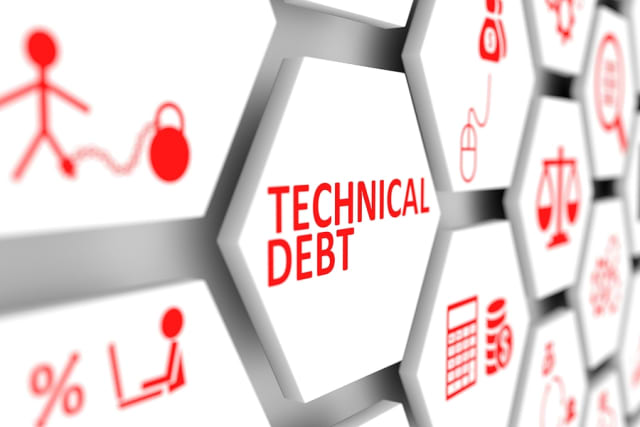Stay ahead of the curve and mitigate technical debt by adopting a strategy to manage in-house tools.
Various interpretations and definitions surround the term “technical debt,” leading to misunderstandings among stakeholders across organizational levels. Contrary to common belief, dealing with technical debt is not exclusive to IT leaders; it inherently represents a broader business issue entangled with gaps in business process governance and data ownership. This issue is further compounded by lacking technology management strategies.

The notion of technical debt can be viewed from different perspectives, including the implicit costs incurred when businesses avoid addressing technical issues or choose to “reinvent the wheel” rather than invest in suitable and fit-for-purpose technology alternatives. This tendency is especially pronounced when the identified problem is perceived as non-essential to the core business or when a short-term “quick and dirty” production patch transforms into a static, long-term solution.
Engineers frequently grapple with technical debt, relying on manual tools such as spreadsheets to manage Bills of Materials (BOMs), CAD files, change management and supply chain tasks—even in the presence of more advanced product lifecycle management (PLM) systems. The cumulative efforts spent on maintaining these makeshift solutions contribute to the worsening of technical debt. Additionally, these in-house tools and legacy workarounds, such as Excel files and email-driven data exchanges, pose significant obstacles to successful digital transformations.
This article elaborates on the inherent challenges associated with technical debt, exploring how strategic business portfolio management and the adoption of advanced technologies, such as PLM solutions, play pivotal roles in effectively mitigating this issue.
Understanding Technical Debt and Its Challenges
Coined by Ward Cunningham in 1992, technical debt compares writing code to taking on financial debt, with the caveat that it should be repaid promptly to avoid complications. As part of a seminar on systems engineering in 2016, the report “Managing Technical Debt in Software Engineering” by Avgeriou et al. later defined technical debt as expedient design or implementation constructs that make future changes more costly, emphasizing its impact on maintainability and evolvability.
Technical debt extends beyond outdated technology, lacking support or reaching obsolescence. Evaluating technical debt requires addressing various criteria, including business value measurement, rework and priorities across both operational and strategic step-change budget owners. To better understand technical debt, ask questions such as:
- How is business value measured, and how are assets amortized over time?
- What level of rework is necessitated by suboptimal processes, technical solutions or associated work methods?
- How are business requirements defined and impact-assessed?
- How are short- and long-term imperatives prioritized, and what trade-offs are implemented based on key design decisions?
- How are enterprise solutions assessed, confirmed as fit-for-purpose, and integrated into the organizational context?
- How are defects and system customizations designed, delivered and maintained?
- How are business solutions architected, designed, built, tested, maintained and decommissioned?
- How are end-users trained, and how does this translate into better decision-making, process and data standard adherence?
- How are supplier relationships managed and how are risks and issues mitigated?
- How are data sets aligned with new processes and systems, contributing to effective business adoption?
- How are both business and IT leaders incentivized to reduce an organization’s technical debt?
Managing technical debt, especially in context of PLM, is challenged by a lack of acknowledgment and procrastination within the business regarding accountability and the understanding of its implications. These questions should shed light on these issues.
How to Manage Technical Debt: Striking the Right Balance
In the financial world, debt is often categorized as either good or bad. Similarly, in technology, technical debt can be viewed through the lens of “good” and “bad,” hinging on risk assessment and mitigation strategies. Technical debt may arise from quick-fix solutions or enabling rapid deployments, especially when driving experimental or interim stages of broader transformation roadmaps.
Many organizations implicitly tolerate technical debt as a necessary investment to adapt to changing circumstances or swiftly seizing new opportunities. Successful businesses stress the importance of managing technical debt through acceptance, measurement and proactive strategies, including the adoption of open standards, abstraction and incremental changes. This often involves cultivating Agile and design thinking and a culture of experimentation.
Conversely, too much technical debt is deemed undesirable due to escalating costs of rework and the postponing of issues until they must be addressed. As with financial debt, strategic decisions, clear communication and a proactive approach are essential to ensuring that technical debt remains a manageable and calculated investment rather than a hindrance to future innovation.
The Role of PLM in Technical Debt Management
Defining and adopting an effective PLM strategy is instrumental in managing technical debt comprehensively. A 2020 McKinsey study titled “Tech Debt: Reclaiming Tech Equity” highlighted the importance of strategic alignment, stating that, “A degree of technical debt is an unavoidable cost of doing business, and it needs to be managed appropriately to ensure an organization’s long-term viability.”
Furthermore, the study emphasized that “the goal is not to reach zero technical debt. That would involve devoting all resources to remediation rather than building points of competitive differentiation. It would also make it difficult to expedite IT development when strategic or risk considerations require it. Rather, companies should work to size, value and control their technical debt and regularly communicate it to the business.” PLM solutions can then be used to track this information.
Taking a PLM approach ensures that integrated business capabilities are maintained throughout the enterprise across five key perspectives:
- People: Centralizing data accountability within all aspects of the business, reinforced by robust adoption guardrails that guide responsible data practices.
- Process: Establishing data-driven processes and the corresponding governance structures to ensure that the flow and utilization of data align seamlessly with organizational objectives.
- Data: Prioritizing data quality by addressing issues related to accuracy, completeness and relevance, thus enhancing the overall integrity and reliability of enterprise data.
- System: Opting for low-maintenance, evergreen solutions, including the utilization of a software-as-a-service (SaaS) and managed service approach. This ensures that systems remain current, efficient and adaptable—minimizing the accrual of technical debt.
- Sustainability: Ensuring that service-oriented architectures are aligned with business goals, designed for scalability and capable of adapting to evolving business needs. This involves continuous monitoring of business performance and strategic alignment with the overarching PLM strategies to promote long-term sustainability.
This holistic PLM approach to technical debt keeps enterprise systems up to date. It’s a proactive stance that aligns technology investments with business objectives, fostering a culture of continuous improvement and adaptability. By addressing technical debt from multiple perspectives, organizations can ensure that their technology landscape remains resilient, supporting innovation rather than impeding it.



